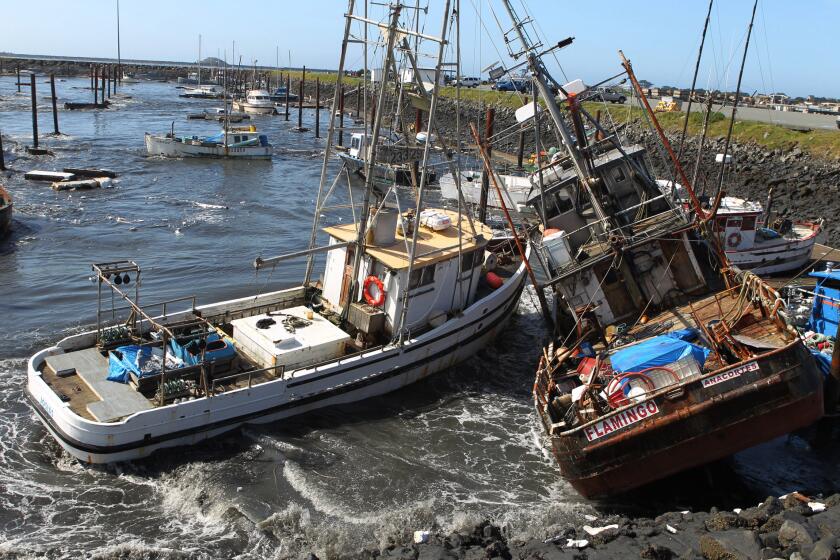Council Grants Extension on Building Repairs : Damage: Owners of steel-frame structures are given nearly three years to bring frames back to pre-quake conditions.
- Share via
The Los Angeles City Council adopted an ordinance Wednesday that gives owners of steel-frame buildings damaged in the Northridge earthquake nearly three years to fix their structures but imposes no inspection or repair guidelines.
Because studies are still under way to find the best way to fix the damaged frames, the ordinance allows owners to choose from a menu of traditional methods to, at the very least, bring the structures back to pre-quake conditions. The owners have the option of adding reinforcement to prevent future quake damage.
Although the ordinance lacks inspection and repair guidelines, city building and safety officials said their department will check the buildings after the work is completed to ensure that the structures meet minimum safety standards to be occupied.
“If owners don’t do an adequate inspection job, we could force owners to redo the inspections,” said Richard Holguin, assistant chief of the city’s building bureau. “We think most structural engineers (hired by building owners) are pretty concerned.”
The nearly three-year period that building owners are given to complete inspections and repairs will also allow state seismic officials time to come up with new repair methods, said Karen Constine, chief of staff for Councilwoman Laura Chick, a member of the council’s Ad Hoc Committee on Earthquake Recovery.
“The reason it was drafted this way was so it would encompass guidelines that are on the way from the state,” she said, adding that the extra long lead time also gives owners more time to find financing for the repairs.
Councilman Hal Bernson, chairman of the committee, also defended the ordinance, saying, “It’s going to be a hardship for a lot of building owners but in the end it may turn out to be a benefit because it may save a building from collapse.”
The damage that the 6.7 magnitude quake inflicted on steel-frame buildings surprised many engineers who previously believed the frames were virtually immune to seismic forces.
*
Widespread reports of cracks in the welded beam connection of high-rise and mid-size buildings spurred several studies in universities and private firms to devise repair methods that will strengthen the connections to withstand future quakes. But state and local agencies have yet to come up with new technical standards.
For now, the ordinance adopted by the council applies only to about 400 commercial steel-frame buildings in the San Fernando Valley and West Los Angeles, locations where damage has been most widespread. But building officials left the door open to expand the inspection and repair requirements to another 600 or so residential and commercial buildings elsewhere in the city.
Since the inspection and repair ordinance was conceived, city officials have relaxed the proposed requirements to give building owners additional leeway to complete what in most cases will be expensive work, Holguin said.
For instance, building and safety officials initially wanted to impose inspection guidelines and require owners to complete the inspections and repairs within two years after the owners receive a city notice, he said.
Instead, building owners have six months after receiving a city notice to inspect the buildings and draft a repair plan. The ordinance then gives them another three months to obtain repair permits and two additional years to complete the repairs.
The inspections alone could cost between $1,500 to $3,000 per connection. Repairs could cost an additional $15,000 to $22,000 per joint. Depending on the number of damaged joints, the bill for inspecting and repairing a high rise could run in the millions of dollars.
But city officials concede that the ordinance still has some weaknesses. For instance, the city has yet to compile an accurate list of steel-frame buildings, and has no projection of when it will.
In an attempt to quantify the problem, a building official spent several months last year identifying 755 steel-frame buildings by combing through computer records and making visual surveys.
A Times survey, however, found numerous steel-frame buildings that were not on the list.
Acknowledging that the list is incomplete, building officials said they saw no reason to spend more time on it until the ordinance has passed.
“We’re going to do a very comprehensive survey,” department spokesman David Keim said.
Keim said the process would involve records checks and street-by-street surveys.
“We have literally hundreds of inspectors,” he said. “Once we actually do it, it shouldn’t take long at all.”
The potential for further delays was viewed as a plus by the Building Owners and Managers Assn. of Los Angeles, which pressed unsuccessfully for the repair period to be extended to five years.
Martha Cox-Nitikman, the association’s manager of governmental affairs, said the current deadlines may place too much pressure on owners to engage engineers and contractors, get financing and move tenants.
Nonetheless, the BOMA views the ordinance overall as a positive step and plans to publish it in its next newsletter.
“This is a positive thing,” Cox-Nitikman said. “Now there is a clear indication of what the city is going to do.”
Although they also generally praised the ordinance, some engineers expressed concerns about its omission of explicit standards.
By leaving the most critical decisions up to building owners and their engineers, the ordinance may expose building officials to problems “because it’s likely that many engineers will have different concepts as to what an appropriate level of inspection is,” said structural engineer Ronald O. Hamburger of EQE International of San Francisco.
Hamburger is program manager for SAC Joint Venture, a statewide partnership of engineers, academics and state officials formed after the Northridge earthquake to formulate guidelines for the inspection and repair of steel-frame buildings.
*
In January, the group published preliminary recommendations on inspection and repair, and is planning to publish its final guidelines this spring. These spell out for different sizes and types of buildings the specific numbers of joints that should be inspected visually and with testing devices.
“The hope is that most engineers will default to the protocol,” Hamburger said.
Some engineers, such as Rawn Nelson, former president of the Structural Engineers Assn. of California, fear that merely repairing some buildings to pre-quake conditions will expose them to the possibility of collapse in a more severe earthquake.
“Based on the type of damage we have seen previously, when the joints were severely damaged . . . there is a large percentage of the engineer community that feels it could lead to collapses,” Nelson said.
More to Read
Sign up for Essential California
The most important California stories and recommendations in your inbox every morning.
You may occasionally receive promotional content from the Los Angeles Times.












